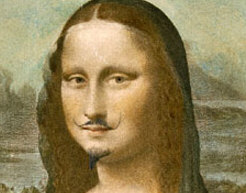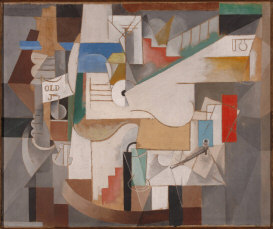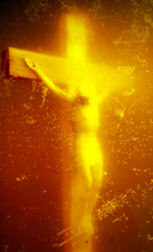|
| By: anonymous - at February 8, 2013 |
The Adverse Effects of Intellectual Property Laws on the World of Art
1. Intellectual Property Law 101
In an age of ever-increasing laws, technology and greed, the controversial
subject of intellectual property law is at the forefront of the art world. At
risk is creativity itself. Artists and authors can no longer "create" or
express themselves freely. Lawrence Lessig contends that "there has never been a
time in our history when more of our culture was owned"(1). Intellectual property law provides these rights of ownership that enable large
corporations, estates, and artists to unjustly prosper financially from them. The power of art is exponential and should be shared and creatively built upon,
as it always has been in the past. It is hard to understand how a society such
as ours, that has so adamantly promoted freedom of expression is progressively
becoming less and less free all the time.
 In order to understand the effects
of intellectual property law on a subject as profound as creativity, it is first
necessary to have a basic understanding of the laws themselves. A copyright is
the "exclusive, legal right to publish, reproduce, and sell a literary,
artistic, dramatic, or musical work" and is designed "primarily to protect an
author or artist against any unauthorized copying of their works" asserts Bielstein(2). In the majority of the world, it is
enforced for the period of time that is linked to the death of the artist. Depending on the country, approximately seventy years after the death of an
artist, the work will go into the public domain, where the image should be
available for free to the public. For example, Picasso died in 1973, therefore,
his work will not go into the public domain until 2043. Keep in mind that this
is regardless of who actually owns the work. The image of Les Demoiselles d' Avignon, is still under copyright protection and is technically controlled by
Picasso's estate. United States copyright law further complicates the
issue of copyright because art created before 1978 was not linked to the
artist's death, it was linked to the first time the piece of work was published. Therefore, if an
artist created a piece of work in 1950 for example, and then published it in
1974, the work would then enter the public domain in 2044. Furthermore, the
Copyright Law of 1909 established that all public works needed to be registered
with the U.S. Copyright Office, otherwise the work is immediately transferred to
be a part of public domain. In order to understand the effects
of intellectual property law on a subject as profound as creativity, it is first
necessary to have a basic understanding of the laws themselves. A copyright is
the "exclusive, legal right to publish, reproduce, and sell a literary,
artistic, dramatic, or musical work" and is designed "primarily to protect an
author or artist against any unauthorized copying of their works" asserts Bielstein(2). In the majority of the world, it is
enforced for the period of time that is linked to the death of the artist. Depending on the country, approximately seventy years after the death of an
artist, the work will go into the public domain, where the image should be
available for free to the public. For example, Picasso died in 1973, therefore,
his work will not go into the public domain until 2043. Keep in mind that this
is regardless of who actually owns the work. The image of Les Demoiselles d' Avignon, is still under copyright protection and is technically controlled by
Picasso's estate. United States copyright law further complicates the
issue of copyright because art created before 1978 was not linked to the
artist's death, it was linked to the first time the piece of work was published. Therefore, if an
artist created a piece of work in 1950 for example, and then published it in
1974, the work would then enter the public domain in 2044. Furthermore, the
Copyright Law of 1909 established that all public works needed to be registered
with the U.S. Copyright Office, otherwise the work is immediately transferred to
be a part of public domain.
Once an artist's work is no longer protected by copyright, it enters the
public domain and is theoretically available for reproduction to anyone. Reproducible images may be ordered from the U.S. Copyright Office, provided that
the work was registered with them. Museums that display and own the works that
they have housed, may also be able to provide images, and an artist's estate
will commonly provide them as well.
Fair use further complicates intellectual property law. The Supreme Court states
that "fair use is the legal mechanism that balances intellectual property rights
with freedom of expression"(3). It provides a safe-guard
that can enable artists and authors to create with more freedom, although within
the context of fair use law. A good example of fair use would be for a
subsequent artist to use an existing artist's work, yet transform it enough so
as not to compete with the original work in the marketplace. These instances are
generally treated on an individual case by case bases, that set the tone for the
status quo of subsequent cases.
Another complication is the orphan work. Orphans are works of art whereupon
the artist is unknown. Subsequently these works go into the public domain. Sometimes it may be difficult for an author to determine the validity of an
orphan.
The ambiguity of intellectual property law can be exemplified in an example
of Willem de Kooning's work. De Kooning died in 1997, which would place his work
in the public domain in approximately 2067, unless of course the work was
produced before 1978. Therefore, de Kooning's Untitled V, created in 1982,
would actually enter the public domain prior to an earlier work, Bar Girl,
created in 1973 (before 1978) and published in 1974(4). Copyright
law is impractical at best.
Intellectual property laws are far more complex than the broad overview that
I have provided. As with most laws, they are also constantly changing.
My point is that you can begin to see the tangled web of the laws themselves and if
you are an artist or author that it might be difficult to work within them.
2. The Legacy of Creativity
Theoretically, this story could begin anywhere. Example after example could be
provided dating back to before the birth of Jesus. For practical purposes, I
will begin in the 19th century: Once upon a time, there was an artist named Paul
Cezanne. Cezanne's work is said to have had a major impact on the direction in
which the representation of art flowed. He used colors that might not
necessarily have been true to nature and he represented objects in the form of
the cylinder, sphere, and cone. Passage, his signature patchwork brushstroke
helped to give his work this more geometric appearance, as well as produce a
flatter, two-dimensional surface. Along came Matisse, who furthered aspects of
Cezanne's work. He liberated color completely and gave new meaning to the
representation of the flat surface of canvas. Picasso followed, and gave birth
to cubism, which was clearly defined and recognized in Cezanne's earlier work. It is well known that Cezanne's The Great Bathers influenced Matisse's Joy of
Life and subsequently, Picasso's Les Demoiselles d' Avignon. Once, it was
considered an honor and a privilege when one artist found inspiration in the
creation of another. Now, intellectual property law supports the annihilation of
the continuum of the historical evolution of art.
  
3. Popular Culture and Creativity
Baudelairean Modernism contends that art should represent modern day life. Art
has historically reflected the popular culture of the time in which it was
produced and provided society with a forum for social commentary. Andy Warhol
epitomized the theory of art reflecting culture through his repetitive message
of co modification of art. This profoundly creative method was constantly
challenged by many with the threat of copyright infringement. Patricia
Search notes photographers Charles Moore, Fred Ward and Patricia Caulfield a few
who filed legal complaints(5). Warhol transformed their
photographs into works of his own. To avoid copyright hassles Rauschenberg
finally began producing his own photographs instead of transforming other
artist's work. Both Warhol and Rauschenberg commonly settled out of court
by creatively bestowing artwork upon their accusers, declares Search(6). Let us be realistic though, how many artists trying to produce something
creative in today's culture are well-known enough to get themselves out of a
financial debacle by paying off their accusers with art?
Another interesting example of the creative depiction of pop-culture with
regard to fair use is found in Tom Forsythe's photograph Food Chain Barbie,
representing one of the most famous pop-culture icons of our time. "Forsythe
jammed nude Barbie dolls in kitchen appliances and photographed them" comments Mcleod(7). Mattel sued for copyright infringement.
Furthermore McLeod reported that in the end, "Forsythe's lawyers spend almost $2
million defending him"(8). Fortunately for Forsythe this
case was taken pro bono, although this supports my argument that creativity is
in jeopardy when it takes millions of dollars to defend a valid claim of fair
use.
4. Ownership
Is the public domain really public? When an estate or museum owns a piece of
art, often times they confuse this ownership with copyright status. An author
searching for the best reproducible image that falls within the public domain
often requests permission from either an artist's estate or a museum in order to
acquire the image. According to the 1947 addition made to the 1909 Copyright
Act, Bielstein observes, that "the copyright is distinct from the property in
the material object copyrighted...the material object shall not in itself
constitute a transfer of copyright"(9). This context
clearly communicates the distinction between copyright and ownership.
It is common practice for museums, as well as estates, to erroneously assume
copyright status. Bielstein requested permission for two works from Georgia
O'Keefe's estate created between 1919 and 1921, thus putting the works in the
public domain. In response to her request, she received permission,
something which she did not technically require, and was charged a copyright fee(10). In addition, Bielstein requested permission for an image owned by The Met,
Petrus Christus' A Goldsmith in His Shop, also in the public domain. The Met
gave her permission, but only if Bielstein agreed "to prominently place on all
copies of the reproductions that are distributed to the public a notice of the
Museum's copyright ownership"(11). They also charged her
a $25 copyright fee. Clearly, both institutions falsely charged copyright fees.
Georgia Balbin, author of Cyclical Catastrophe, an expansive documentation of
Catastrophe Theory(12), explained the artwork of many
ancient cultures. Balbin reasoned that it was virtually impossible to research
the ownership of the images needed to prove her theory. In response to this
dilemma, she re-created the work hersel(13). Re-creating
the artwork herself took her far more time, money, and effort than if she would
have been able to use images she found during her research.
Bielstein requested those images to prove the point that museums and estates
often charge fees that they are not entitled to charge, since the work is in the
public domain, and therefore free. Most authors want to publish meaningful
insights in conjunction with the images of art needed in order to convey them. How can they continue to do so if intellectual property laws exist to promote
the publication of art as a commodity and not for the enrichment of our culture?
5. The Value of Art
Repeatedly reproducing art, either through an artist's inspiration, evident in
an earlier work by another artist, or via publishing, nourishes our culture in
the history of art and ultimately increases the value of art. Consider the
popularity of works of art like the Mona Lisa and Les De Moiselles d' Avignon. How many times have you seen these images? Does their popularity increase sales
at the Louvre and the MOMA? Absolutely. Could a modern day Duchamp alter a piece
of work comparable to the Mona Lisa today and expect no recourse? Probably not,
because ultimately, due to intellectual property laws, an artist's creativity is
limited.
 According
to McLeod, The Berkeley Pop Culture Project reported that the three most
commonly reproduced images were Mickey Mouse, Jesus, and Elvis in the 1990s(14). Of these three, clearly Jesus is in the public
domain. Do artists need to return to medieval subjects to avoid self-censorship
in order to express themselves freely? Probably not, given the example of Andres
Serrano's Piss Christ. Not even images of the Son of God can be creatively
expressed without unjust criticism. According
to McLeod, The Berkeley Pop Culture Project reported that the three most
commonly reproduced images were Mickey Mouse, Jesus, and Elvis in the 1990s(14). Of these three, clearly Jesus is in the public
domain. Do artists need to return to medieval subjects to avoid self-censorship
in order to express themselves freely? Probably not, given the example of Andres
Serrano's Piss Christ. Not even images of the Son of God can be creatively
expressed without unjust criticism.
Intellectual property laws are inflicting a deadly blow upon the world of
art. The legacy of creativity reflected in the historical development of art has
been and is being significantly altered. Popular-culture is not truly reflected
in today's art. Museums, estates, and corporations take advantage of authors by
charging erroneous copyright fees. Art is no longer of real value if artists
cannot create freely.
Notes
1. Lawrence Lessig, Free Culture, The Nature and Future of Creativity (London;
Penguin Books, 2004), 12.
2. Susan M. Bielstein, Permissions, A Survival Guide (Chicago: The University of
Chicago Press, 2006), 12.
3. Eldred et al. v. Ashcroft (01-618), 537 U.S. 186 (2003); quoted in Bielstein,
Permissions, 79.
4. Bielstein, Permissions, 24.
5. Patricia Search, "Electronic Art and the Law: Intellectual Property Rights in
Cyberspace," Leonardo 32, no. 3 (1999):193
6.Ibid., 193
7.Kembrew McLeod, Freedom of Expression, (Minneapolis, University of Minnesota
Press, 2007), 143.
8.Ibid., 145.
9.Bielstein, Permissions, 30.
10. Ibid., 28.
11. Ibid., 48.
12. A theory based on the work of Immanuel Velikovsky that the earth experienced
multiple catastrophes involving other planets in the solar system.
13. Georgia Balbin, author of Cylclical Catastrophe, interview by author, Akron,
Ohio, 10 September 2008.
14. McLeod, Freedom, 143.
Bibliography
Balbin, Georgia. Cyclical
Castastrophe. (Boulder, Colorado: TET Publishing, 2005).
Bielstein, Susan M. Permissions, A Survival Guide. (Chicago: The University of
Chicago Press, 2006).
Lessig, Lawrence. Free Culture, The Nature and Future of Creativity. (London:
Penguin Books, 2004).
Mcleod, Kembrew. Freedom of Expression. (Minneapolis: University of Minnesota
Press, 2007).
Search, Patricia. "Electronic Art and the Law: Intellectual Property Rights in
Cyberspace." Leonardo 32 no. 3 (1999):191-195.
Legal
Top 20 Most Ridiculous Lawsuits
25 Funny & Crazy Arrest Stories
10 Innocent People who Died on Death Row
Top 15 Myths About Guns
15 Cool Things Prisoners Get To Have In Jail
Top 15 Illegal Drugs That Used To Be Legal
15 Unusual Ways Crimes Have Been Solved
15 Survivor Accounts of Gruesome Crimes
Top 20 Most Ignored Road Signs & Their Accidents
15 Fascinating Facts about the Mafia
15 Weird Actions That Are Prosecuted in the Modern World
15 Legal Counsel That Have Never Lost Court Cases
The Adverse Effects of Intellectual Property Laws on the World of Art |